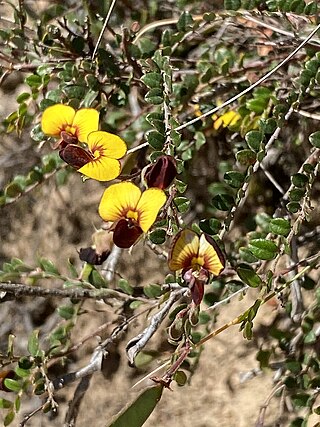
Lasiopetalum maxwellii is a species of flowering plant in the family Malvaceae and is endemic to the south coast Western Australia. It is a sprawling shrub with hairy young stems, lance-shaped to oblong leaves and white to cream-coloured flowers.

Thomasia quercifolia, commonly known as oak leaved thomasia, is a flowering plant in the family Malvaceae and is endemic to the south-west of Western Australia. It has egg-shaped, lobed leaves with a heart-shaped base, and pink to mauve flowers.

Thomasia grandiflora, commonly known as large-flowered thomasia, is endemic to the south-west of Western Australia. The flowers are pinkish-purple with a papery appearance hanging in pendents from the leaf axils. The calyx lobes are prominent and larger than the petals.

Bossiaea prostrata, commonly known as creeping bossiaea, is a prostrate understory shrub in the pea family, Fabaceae. It is a widespread species with orange-yellow flowers, purple-brown keels and trailing branches.

Thomasia solanacea is a species of flowering plant in the family Malvaceae and is endemic to the south-west of Western Australia. It is an erect, bushy shrub with egg-shaped leaves, the bases heart-shaped, and racemes of white, cream-coloured or pink to purple flowers.

Seringia nephrosperma, commonly known as free-carpel fire-bush, is a species of flowering plant in the mallow family and is endemic to northern Australia. It is an upright, suckering shrub with hairy new growth, usually oblong to lance-shaped leaves, and purple flowers arranged in groups of 5 to 25.

Thomasia angustifolia, commonly known as narrow-leaved thomasia, is a species of flowering plant in the family Malvaceae and is endemic to the south-west of Western Australia. It has densely hairy young stems, narrowly oblong, wrinkled leaves and pinkish-purple, bell-shaped flowers.

Commersonia corniculata is a species of flowering plant in the family Malvaceae and is endemic to the southwest of Western Australia. It is an erect to prostrate shrub with 3-lobed, egg-shaped leaves, and white to cream-coloured flowers.
Lasiopetalum cardiophyllum, is a species of flowering plant in the family Malvaceae and is endemic to the south-west of Western Australia. It is an erect shrub with egg-shaped to heart-shaped leaves and groups of pinkish flowers.
Lasiopetalum compactum, is a species of flowering plant in the family Malvaceae and is endemic to the south-west of Western Australia. It is an erect shrub with leathery, narrowly oblong leaves and cymes of white to pinkish flowers.

Lasiopetalum glabratum is a species of flowering plant in the family Malvaceae and is endemic to the south-west of Western Australia. It is an erect shrub with densely hairy young stems, egg-shaped leaves and pale mauve-pink reddish-purple flowers.

Lasiopetalum glutinosum is a species of flowering plant in the family Malvaceae and is endemic to the south-west of Western Australia. It is a spreading, multi-stemmed shrub with densely hairy young stems, egg-shaped leaves often with three lobes and bright pink or dark red flowers.
Lasiopetalum laxiflorum is a species of flowering plant in the family Malvaceae and is endemic to the south-west of Western Australia. It is a sticky, straggling subshrub or shrub with many densely hairy stems, egg-shaped leaves, and bright pink and dark red flowers.
Lasiopetalum monticola is a species of flowering plant in the family Malvaceae and is endemic to the south-west of Western Australia. It is an erect, slender or straggling shrub with densely hairy branchlets, leaves and flowers, egg-shaped leaves and pink, cream-coloured or white flowers.

Lasiopetalum pterocarpum, commonly known as wing-fruited lasiopetalum, is a species of flowering plant in the family Malvaceae and is endemic to a restricted area in the south-west of Western Australia. It is an open shrub with many densely hairy stems, egg-shaped and lobed leaves and pink and dark red flowers.

Lasiopetalum rotundifolium is a species of flowering plant in the family Malvaceae and is endemic to the south-west of Western Australia. It is an erect to spreading shrub with hairy young stems, round leaves with a heart-shaped base, and pink and dark red flowers.
Thomasia × formosa is a species of flowering plant in the family Malvaceae and is endemic to a restricted area of the south-west of Western Australia. It is an erect, compact shrub with densely hairy branchlets, hairy, coarsely serrated, egg-shaped to elliptic or oblong leaves, and racemes of pink or purple flowers arranged in leaf axils.

Thomasia stelligera is a species of flowering plant in the family Malvaceae and is endemic to the south-west of Western Australia. It is a low, spreading shrub with scattered, narrowly oblong leaves, and racemes of mauve flowers.

Androcalva crispa, commonly known as crisped leaf commersonia, is a species of flowering plant in the family Malvaceae and is endemic to the south-west of Western Australia. It is a prostrate shrub that forms suckers from rhizomes and has densely new growth, clusters of lobed, egg-shaped or oblong leaves with wavy, serrated edges, and groups of white and pinkish-purple flowers.
Guichenotia anota is a flowering plant in the family Malvaceae and is endemic to a restricted part of the southwest of Western Australia. It is a low, erect, compact shrub with hairy new growth, oblong to narrowly egg-shaped leaves, and pinkish-purple flowers.
















